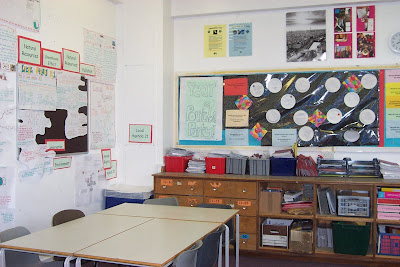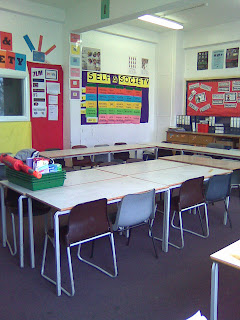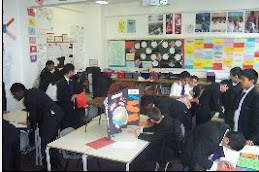Friday, 2 October 2009
Friday Fun: UCAS statement guidance
You should them this wonderful slide and explain that this is what they sound like.
That's it until next week....Enjoy!
Thursday, 1 October 2009
Top Ten Tips for Teachers Who Want to Integrate Technology into their classrooms
1.There are new sites, apps, downloads, and learning tools created every day. You can stay up-to-date by conducting research online, reading education technology blogs, and listening to podcasts like TILT or The Teacher's Podcast.
2. Find out how other teachers are using technology. Talking with others can sometimes be the best way to get new ideas or explore unknown technological advances. There are several websites and social networks dedicated to providing a forum for teachers who want to discuss educational technology. A good site to try is Classroom 2.0.
3. Try the technology first. New technology (or technology that is new to you) can sometimes be problematic. It is best to test it out before you present it to a classroom full of students. Pre-testing will allow you to work out any bugs and customize the tech tool for your class.
4. Know the rules. There are some school systems that have very specific rules about integrating technology in the classroom. Most of these rules have to do with student privacy or security, and may require that you seek parental permission.
5. Speak to the headmaster or school administrator. Letting someone else know that you plan to integrate a new technology in the classroom is a good way to avoid problems later on. Principals and school administrators are sometimes more familiar with the rules and pending laws in the state. Speaking to them ahead of time protects you, your job, and the school you work for.
6. Start slowly. Once you have decided to integrate technology in the classroom it can be tempting to go wild and use it at every opportunity. Unfortunately, this isn’t always the best approach. You may be better off introducing one new idea or tool at a time so that your students do not feel overwhelmed by too many changes.
7. Monitor students carefully. Although this probably goes without saying, it is important to remember that students can be vulnerable when they are online. It is essential that you monitor their work and their use of web technologies to ensure their privacy is being protected.
8. Track results. This will help you determine whether or not the new technology is working or taking away from the classroom experience. There are, of course, many different ways to track the results of your technology experiment. For example, you could measure success by excitement, skill improvement, or grade improvement.
9. Get feedback. One of the best ways to determine whether or not your technology experiments are successful is by asking students to provide you with feedback. You can ask for verbal responses or written responses. You can also gauge student opinion with an online survey or poll created on sites like SurveyMonkey.com and ProProfs.
10. Don't be afraid to make changes. If you find that a technology isn't working quite like you hoped, make changes to it. Many of the educational tools that can be found online are customizable. Those that aren’t can be replaced with something that works better for your classroom and teaching style.
Guest post from education writer Karen Schweitzer. Karen is the About.com Guide to Business School. She also writes about online colleges and universities for OnlineColleges.net.
Wednesday, 30 September 2009
Lego in the classroom: A Learning Tool

During half-term I am visiting an amazing fellow Masters student in Denmark to take part in a Lego 'Serious Play' conference. Businesses are now paying Lego for 'strategy kits' from which business leaders construct processes, metaphors for their organisations, and so on. This works as it is concrete and memorable. Lego can have a similar effect in the classroom. Have students use old Lego bricks (you can find cheap bags on ebay) to create items relevant to your subject - redo the Battle of Hastings, make a neural pathway or reinterpret a poem.
The process of 'play' is creative and knowledge-building for students, and the outcomes are both meaningful and visual causing them to transfer more easily into long-term memory.
For more info on this read more at http://learninginstitute.lego.com/en-us/Default.aspx
Tuesday, 29 September 2009
Return of DTT: Student Handbooks
A hectic summer has meant a late start but I am now back. I will be putting all the week's posts up first on http://weeklyteachingtips.blogspot.com and then putting daily chunks on here assuming I am able to get near a computer in the morning. My new job has shifted my time priorities a little so I may not be quite as timely as before but I will do my best.
On with the first post for 2009-10:
Student Handbooks
As an experienced teacher I know the best way for my classroom to function however the students I meet each year do not. After beginning with questionnaires, name and team games so that students can get to know each other it acn be very helpful to give your students an introductory handout or handbook (depending on their age and complexity of the course). I try to avoid too much of the 'rule' based stuff but I do give information on what the course is, why I like it, what students should do to achieve well and what they can expect from me. You can find examples here: Year 10 Citizenship, Year 12 SHD Diploma & Year 13 Psychology.
This year, for the first time, I printed extra so students could take an extra copy for their parents. I was amazed (and heartened) how many students took the extra copies and have since mentioned how helpful it was as their parents usually bug them relentlessly about the content of their school work.
Wednesday, 5 August 2009
DTT Is On Vacation
I am (finally) having a holiday until 18th August so no DTT until then. Don't worry though, the 'Systems' strand will continue at the end of the month and I will be concentrating on a whole series of tips for dealing with the beginning of term from my return through until the end of September.
Best wishes,
Laura
Thursday, 30 July 2009
System 3: Keeping your books in order!
 I had the added problem that I would forget to collect in resources used in the lesson. For instance, there would be 30 seconds of lesson time left but glue sticks, worksheets, laminates AND books were still everywhere. How could I quickly collect things in and move to the next set of pupils without losing track of myself?
I had the added problem that I would forget to collect in resources used in the lesson. For instance, there would be 30 seconds of lesson time left but glue sticks, worksheets, laminates AND books were still everywhere. How could I quickly collect things in and move to the next set of pupils without losing track of myself?1. Get a set of drawers near the door to be used for that day's classes. Period 1 resources were kept in drawer 1. Period 2, drawer 2. And so on. At the end of the lesson I then frantically pulled all the resources back in, threw them into the drawer, and then opened the next drawer down to find my new set of freshly prepared materials.

Wednesday, 29 July 2009
System 2: How to encourage students to be in your classroom on time!
Having a positive meaningful start to lessons encourages students to be there from the beginning. Being at the door and out in the corridor (if necessary) also encourages everyone inside. But although setting up a good classroom atmosphere will entice most students in punctually what can I do if students are not on time?
I use a lateness chart pinned to my wall to deal with this matter. Students know that if they need to enter after the classroom door has shut (the door is my signal for 'we are working now') then they must knock. When it is appropriate and they can enter they must 'sign-in' on the lateness log. Doing so serves two purposes; firstly it means that if I have taken the online register and the fire bell goes then I have a record of who is additionally in class to the web-register and, secondly, it means I can remember at the end of the lesson who I need to speak to.
This process works for students because it is quick, consistent and it doesn't mean that I am asking questions in front of everyone as students sometimes are embarrassed about the reasons they are late. There's very little argument about signing up as students know if they have a good reason then they can explain at the end (there are no automatic sanctions in my room for lateness). Also, it means students move straight to learning after the writing. This is my main goal, if they have already wasted time then I don't want them to waste anymore.
This year I had an additional complication to the system because I didn't have a classroom, so I invented 'clock-in' cards that work on the same principle but I hand them to the student when entering the classroom. It's slightly harder to keep track of (I'm partial to losing clock-in sheets under papers on the desk) but it's almost as good as the sign-up sheet.
At the end of the lesson I speak to students and decide on an appropriate consequence depending on their reason - maybe time off break, additional work or something else. I also make it clear that if the lateness persists (and I can check regularity as I keep completed lists in a file) there will be more serious consequences along my warning scale (which I will explain shortly!).
